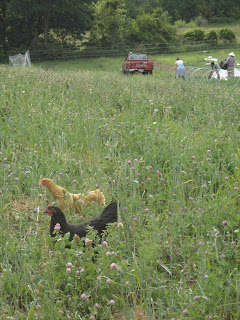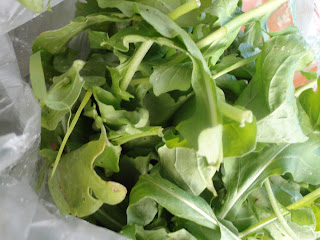I was lucky enough to have the opportunity to head out to the Rhine Center Vegetable Club two weeks ago, to spend a day working on their farm. Some people, I recognize, may not consider this an "opportunity." They might consider it in fact hard work, and me a sucker for doing it. I disagree.
 |
| The farm. |
As you might have noticed, I consider myself somewhat of an avid gardener. I would say my garden plot is bigger than the average city dwellers, and it's supplemented with containers throughout my yard and house. That being said, I was shocked at the amount of time that it takes to work a true farm when you're not using big machines, pesticides, and migrant labor. I spent about the first five hours of my seven hour day thinning and weeding the beets. Jess and Sam (the real farmers) were planting a new field that they hadn't used in the past, and they weren't sure how fertile it was, so they triple seeded the beets. Unnecessary, because the beets came in just fine. However, if the plants were just left as is, it would have meant that the beet roots would be too crowded, and the beets would not grow in as big round bulbs. Instead, they'd just be roots. So, we had to go down the lines, find patches of overcrowded beets, carefully select the plant that appeared to have the smallest root (which of course you couldn't really see), pull it up, snip off the root, and save the greens to go out in boxes to the CSA members.
 |
| Beets |
 |
| Rows and rows and rows and rows (actually four rows) of beets |
 |
| It was hot. I actually picked far more beet greens than this, but they got snatched away faster than I could take a picture to keep them from wilting. |
The rest of my time was spent harvesting and trimming kohlrabi, and picking kale. The kale was actually my favorite, because the wilty and otherwise less than pretty leaves went over to the pigs for a snack. I enjoy pigs, both in person and in my belly, and these guys were especially friendly. They did, occasionally, appear to want to eat my feet, and I had to remind them that this was backwards - I eat them not the other way around.
 |
| Kohlrabi and Kale |
 |
| Nom nom nom... |
 |
| This is a pig who appreciates his veggies! |
I'm sure that some of you are finding this disturbing. These are happy, living creatures, snorting around eating their kale, and I'm thinking about eating them. Cruel. On the other hand, though, they do have a happy life. And that happy life is paid for by my future consumption of them. These pigs have, in my opinion, a much happier and healthier life than than their Wild Boar counterparts. They have land to roam free, all the kale (and plenty of other goodies) that they can eat, fresh water, and medical care if needed. And, they're not at risk of being hunted by tigers (wild boar are the main and preferred food source for tigers in the regions where they co-exist, and tigers have been known to chase boars for longer distances than other prey), wolves (a single wolf pack can consume an average of 50-80 wild boars annually, and in Italy wild boars have become so defensive against wolves that they have been known to attack domesticated dogs), and hyenas. Baby boars are food for pythons, large birds of prey, large cats, dingos (dingos ate my boar baby!), large bears, and crocodiles. (Source: Wikipedia, of course!)
So if I don't eat them, someone will.
 |
| Like this guy. He will eat the pig if I don't get to it first! |
Seriously, though. I'm not going to become a vegetarian. I respect the views of people who are vegetarians, just as I respect the views of anyone who is making a conscious effort to think about what they eat - whether it be for their own health, environmental reasons, or moral reasons. Thinking about what you eat is good. I personally believe that meat is an important part of the human diet. We are, omnivores by nature. No, it is true that we do not need to be, but our digestive system is set up to process meat and vegetables. Looking at people who eat the "Paleolithic Diet" or "Caveman Diet," they are mimicking the eating habits of our hunter-gatherer ancestors, who were just that: HUNTER-gatherers. (Please do not read this as my advocating for the Paleo diet. While it's interesting, and again a good way to be paying attention to what you eat, I think it's a little bit silly to take in calories like early humans when we are not expending calories like them. Every time you get in your car, don't hunt your own food, don't forage for your own veggies, etc. you are taking a step further away from what early humans did, so your caloric needs are going to be different. Plus, the Paleo diet forbids alcohol, which is just inconceivable in my mind.) What is important to me is knowing that the animal that sustains me was likewise sustained. I have heard some of my more passionate vegan friends say that eating meat is slavery for the animals. While I can see where they are coming from, I see it more as a symbiotic relationship. I am as dependent on that animal for survival as they are to me. I feed them, care for them, and water them, and in return they sustain me. The quality of sustenance I receive from them is equal to the care that they receive. Happy food just tastes better.
Most local farmers - at least the local farmers I know in Wisconsin - appreciate having people out to their farm. This is their job, but it is also their passion and their art. They are proud of it. Farming is a dying skill, which is terrifying because without farmers there is no food. But, really, how many of your friends wanted to be a farmer when they grew up?
 |
| These people might have wanted to be farmers when they grew up. They're kick ass farmers now, regardless. |
So, I highly recommend spending a day on a farm. It's hard work, but I promise you will leave feeling satisfied. If you get a CSA, often times the farmer will allow you to pay some of your share cost in labor. Some even offer "Worker's Shares," in which your CSA share is paid for or supplemented by your commitment to put in a certain amount of time at the farm each week or month. I took away from my visit a sense of accomplishment, a renewed energy for my passion in local food, a sunburned knee (just one...), and the knowledge that I was going to get a hell of a good sleep that night! I also had the opportunity for a truly amazing lunch with my hosts, and got to learn more about the people who are kind enough to feed me every week. It's nice to realize your food comes from somewhere other than the shelves of a grocery store, or a truck before that, or a distribution center before that. And it's also nice to think about the amount of work that goes into creating your food. I know for me, it renewed my commitment to waste as little food as possible. Those beet tops, the carrot greens, the green shoots the garlic sent up, those chicken livers and those pigs feet, they all took time and love and energy to create. We should not be considering them garbage and tossing them away.
And, who knows, maybe you'll change your mind and want to be a farmer when you grow up!
Extra bonus recipe:
Early Summer Beet Green Risotto

- 6 cups chicken stock
- 2 tbsp olive oil
- 1 large green onion, thinly sliced including tender green parts
- 1 garlic scape, thinly sliced
- 2 cups Arborio rice
- 1/4 cup white wine
- salt and pepper
- 3 cups thinly sliced beet greens
In a large frying pan with high sides, heat the olive oil over medium high heat. Add the onions and garlic, and saute just a few minutes until fragrant. Add the rice and continue to cook, stirring constantly, for about five minutes. The rice should be translucent with just a small white dot in the center. Add the white wine, and cook, stirring constantly, until the wine has evaporated. Reduce the heat to low. Add the chicken stock about 1 cup at a time, stirring vigorously after each addition, and adding another cup when the rice is almost dry on top. Season with salt and pepper. Around the 4th cup you want to start tasting to see where your rice is in terms of doneness. The rice should be just barely firm, and creamy (you may not use all 6 cups of stock). Add the beet greens with the last addition of stock.
Now enjoy some pictures of happy chickens, pigs, and beets. For the rest of my pictures (no, this is not all of them!), visit my Facebook page https://www.facebook.com/HomeGrownHomemade. Consider giving us a like while you're there!:













































